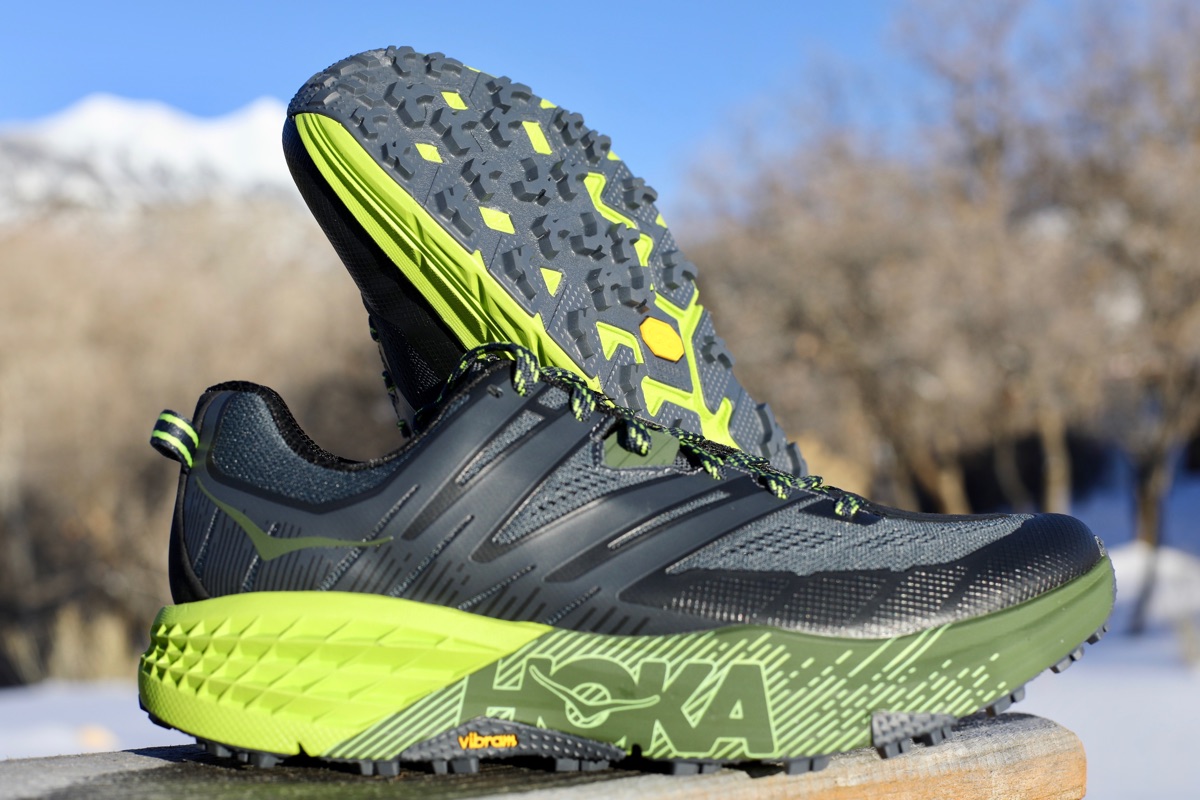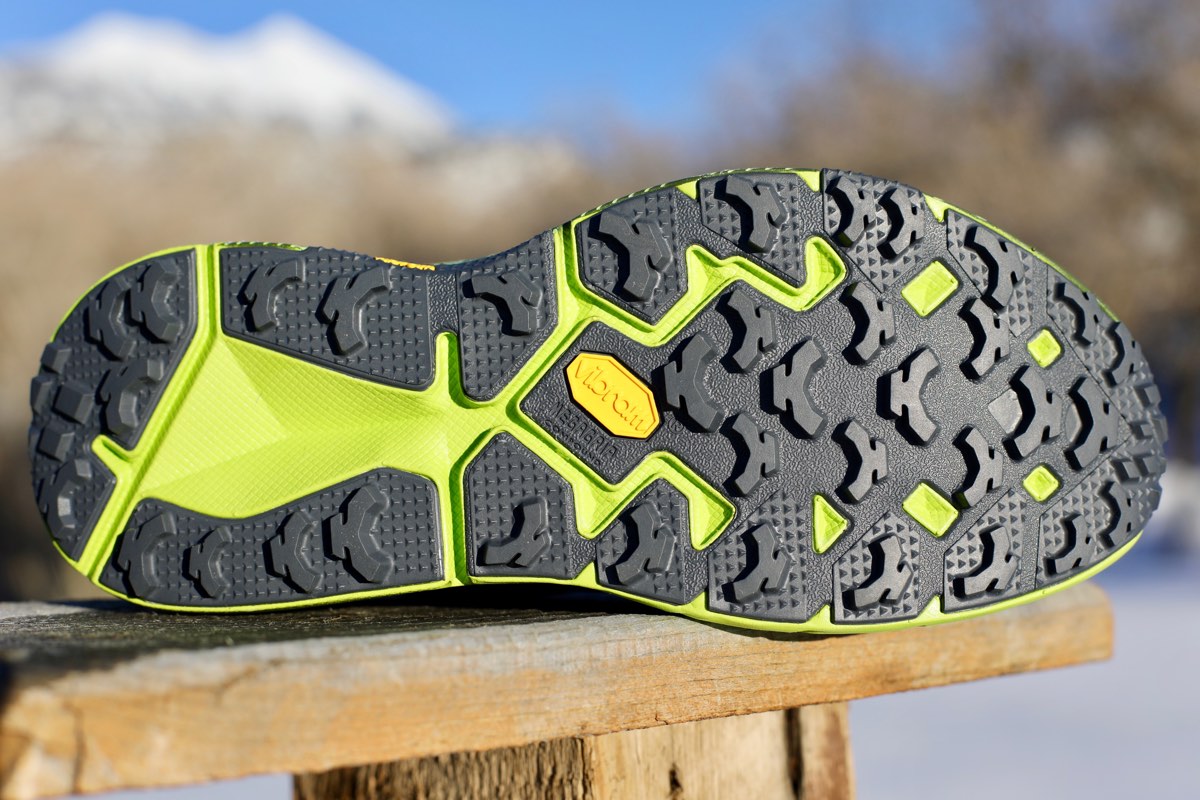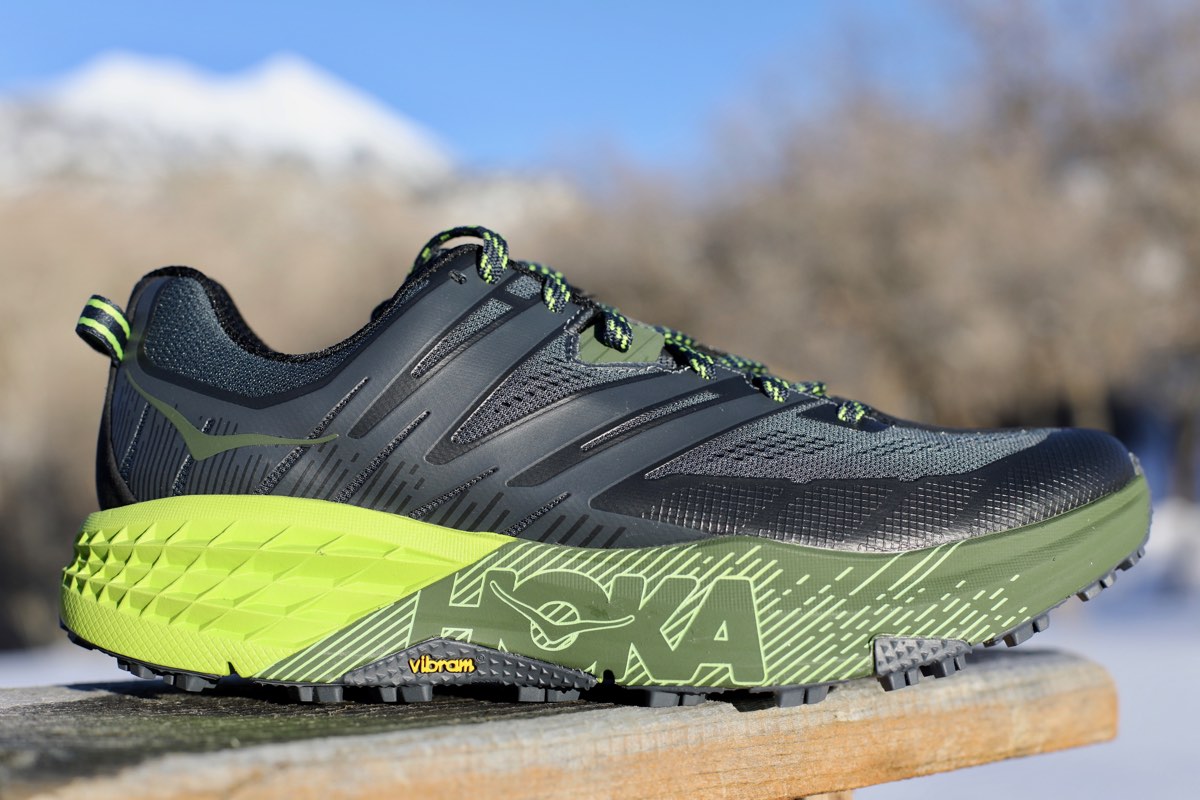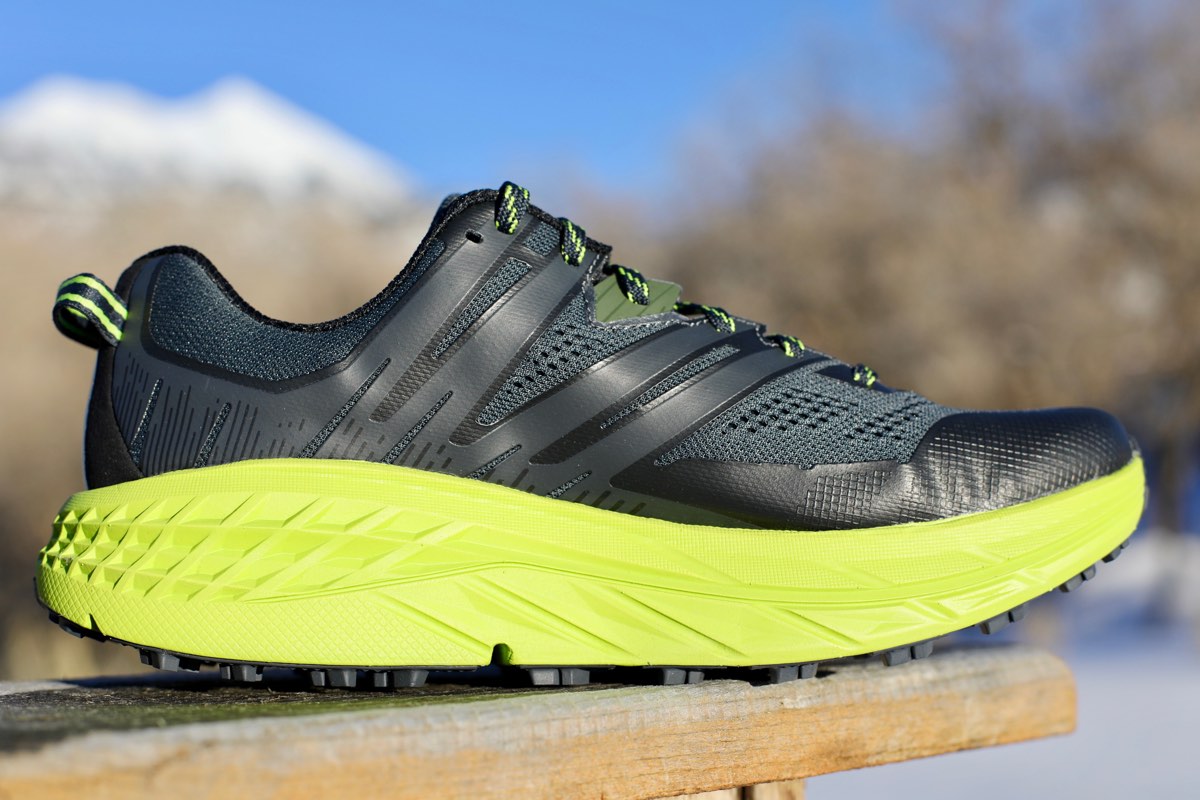For the latest on the Hoka Speedgoat, you can read and watch our Hoka Speedgoat 6 review.
Our Favorite Trail Running Shoes
Check out our Best Trail Running Shoes article to learn about our current favorite trail running shoes!
Hoka One One Speedgoat 3 Review
I see the Hoka One One Speedgoat 3 ($140) on a lot of feet these days, including on my local, groomed trails and trudging through the mud and technical terrain of an island in the Pacific Ocean. The Speedgoat has certainly gained a following for its versatility. In this third version of the do-it-all trail running shoe, we see only slight tweaks to version two’s formula. The tread and midsole stay exactly the same save for the drop changing from 4.5 to 4mm. For those unfamiliar with this bottom-package combination, this means a maximal shoe with responsive cushioning and a very capable tread pattern built on the Vibram Megagrip compound. The upper sees changes to provide better midfoot lockdown and some more comfort in the toes and heels, at a cost of an extra ounce of shoe. Watch the video to learn more about the Hoka One One Speedgoat 3.
Hoka One One Speedgoat 3 Review Transcript
Hey and welcome to Trail Trials, and on today’s video we are going to take a look at the Hoka One One Speedgoat 3. This is a 10.3-ounce (men’s size 9) and 9.1-ounce (women’s size 7) shoe. It has a 4mm drop and some updates to the upper. With that information, let’s get into it and see what this shoe is all about.
Hoka One One Speedgoat 3 Outsole
I think the best place to start is on the tread. If you are someone who has worn the Speedgoat 2, if you look at it from the bottom, you wouldn’t be able to tell the difference between the 2 and the 3. To illustrate that, here’s the 2 and here’s the 3 [shows both models]. You can see they are identical or practically identical. You’ve to a little bit [of variation] maybe in the designs here, but for the most part, you’re looking at exactly the same types of lugs, lug depth, and material, which is the Vibram Megagrip.
I like this tread pattern. I like this lug depth. I like this compound quite a lot. It works in a variety of different areas. This summer, I wore the Speedgoat 2s crossing half the state of Oregon via the Pacific Crest Trail. I wore Speedgoats on all dry trail, rocky, sandy, and a little bit of everything, and these shoes held up great. In January, I ran a race over in Hawaii, and it was muddy, wet, lots of rocks, and lots of roots, and I think these things did as well as just about anything else I could have worn. The nice thing about that is you just have a really good go-to tread pattern that works well across lots of different types of terrain. I think they’ve done a really nice job with that.
For specifics, you have your uphill lugs here, your downhill lugs in the back for braking—grabs here and grabs there [pointing to the front and back of the outsole]—some various patterns in the middle for varied terrain and those types of things. There are cutouts in the areas where maybe you don’t need a lug because it’s in an area where you’re not toeing off of or braking with that middle part of your heel, so they’ve removed that for weight-saving purposes.
Hoka One One Speedgoat 3 Midsole
Let’s switch over to the midsole. The midsole is listed by Hoka as a neutral midsole. There are no other compounds in here or different types of foam with different hardnesses to create a post or anything like that. This is listed as a neutral shoe. In terms of between cushion and hardness, this shoe stops right there in the middle. It’s not overly cushy, and it’s not overly hard. What does that mean? That means it’s not going to be the most cushion you can get from Hoka, but it’s also not the hardest. You’ve got a little bit of responsiveness, and you’ve got a bit of cushion for the long haul, which that’s what this shoe is built for. This is the Speedgoat. It’s named after Karl Meltzer. Karl is the 100-mile guy with a lot of 100-mile wins to his name. That’s the intent here. This is a shoe that is built for comfort, agility, speed, and the best of everything.
As we work our way around, you can see it’s a very simple foam. There is no rock plate in here. I will say based off of wearing this shoe a lot and being in varied terrain, from very extreme stuff to regular, the lack of rock plate is not really noticed. I think that’s going to be the case on most maximal-cushioned shoes because it takes a lot for a rock or a thorn or anything like that to poke through the rubber. If it does happen to poke through one of these types of spots, it has a long way to go before it actually gets into the shoe itself. No rock plate, but I don’t really notice it at all.
Hoka One One Speedgoat 3 Upper
Where this shoe is really different from the Speedgoat 2 is in the upper. The upper has had, I would say, some nice changes, which is this little area right in here [points to cutout notches in the midfoot part of the upper]. It’s really just these cutouts here. The point is, it really grabs and makes a little better pull onto your foot with a little more midfoot stability. Hoka actually says the difference between the 2 and the 3 is improved midfoot and improved heel. I always liked the 2 and thought the 2 locked down the foot pretty well, but this goes just a little bit farther and gives even a little more snug of a feel to it, which I really like. Again, it’s not overly noticeable or an overly tight-fitting shoe compared to the Speedgoat 2, but there is enough refinement to warrant a nice little upgrade.
The heel, I don’t really notice a whole lot there. I didn’t have any problems with the heel, but they’ve said the heel has a little bit of a better fit in this version over the other.
The place where I struggled with these and where I still continue to struggle is this little piece of fabric right here [points to fabric area in toebox part of upper]. I don’t know why it’s there, and I wish they would take it away. However, there is a little bit more room in this toebox over the last version, just a little bit taller than it was before. But this piece of fabric here, I feel like my toe is always getting caught a little bit on it. It’s really just on my right foot. My left foot doesn’t have it, but all feet are different. My only sort of ding on this shoe is this little thing here.
Overall, it’s really good. You can see this rand runs all the way around the shoe does a nice job for mud and keeping gunk from being in there while also creating a bumper to make sure when you’re kicking toes on rocks and stuff you’ve got a little bit of solid material to keep it from coming in.
In my previous Speedgoat 2 review, one of the things I noted was that I was having early signs of wear in the very early miles on the shoe. They actually updated that in the second round of color release in the Speedgoat 2 and made a very similar pattern in what we see in this overlay and they removed some of the pinch points that existed before. What I can say in my testing of this shoe to date, which is quite a bit, we aren’t seeing any of that premature wear that I experienced with the last ones.
A couple other things I’ll point out here is a slightly refined tongue—a little more smoother and a little wider and wraps around the top of your foot better. It’s still not gusseted, which I wish they would do, but it’s not the case here. So again, it’s a really, really minor update, I would say, to this shoe overall, but it is enough to warrant a nice little upgrade because it does wrap around the foot a little bit better and again, it does—for those who are looking for it–have a little more refinement in the heel and just a bit more room in the toe.
Hoka One One Speedgoat 3 Overall Impressions
In closing, if you liked the Speedgoat 2s, you’ll like the 3s. There isn’t a whole lot that has really been changed here. You have a slightly better-fitting upper. It’s a little more streamlined. You have a little bit better-fitting heel and a little bit more room in the toebox here. If you were someone who were in on the early parts of the Speedgoat 2s before they made the update around the toe and had some of that blowing-out area, this seems to be doing just fine. I wore the Speedgoat 3s for a pretty rough race at the HURT 100 Mile, and they look fine. They survived some pretty nasty conditions there. I’m super pleased.
What I would say about this shoe, if you haven’t worn the Speedgoat before, this is a pretty good all-around trail shoe. If you want a little bit more cushion, obviously you know what you’re getting into with the Hoka, but this thing does well with a lot of things. I travel a lot for work, and this is the shoe that tends to go with me because it’s not that heavy. The tread and the grip isn’t so deep that it affects running on the road. It works well in technical and rocky conditions. I’ll wear it on the treadmill. It works in a lot of places. That’s why it’s the shoe I generally grab for when I don’t know what I’m getting into.
Read up on more new trail shoes for fall-winter 2019.
Call for Comments
Questions, comments, your own experiences? Leave them below this video. Thanks for watching, and we’ll catch you next time.
[Editor’s Note: If you’re affiliated (i.e., an employee, ambassador, etc.) with a shoe brand, please share your relation in each of your comments on this article. Thanks!]





